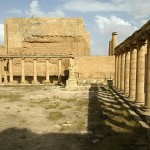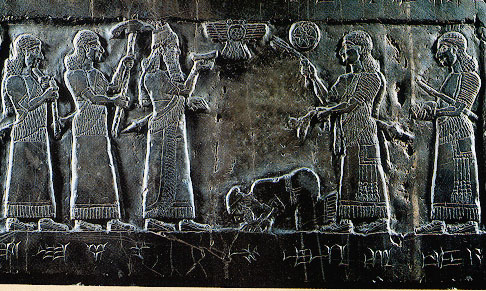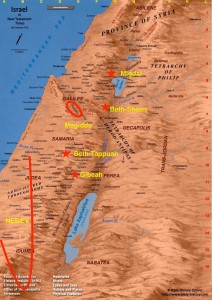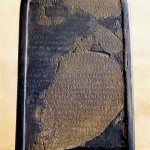The specific purpose and intent of this entry is to present research on biblical overlaps with archaeology. Literature that falls in the category of mythical will not be covered even though there is a large amount of biblical and extra-biblical literature that refers to the same events, such as creation and flood events. Information will be sectioned off into multiple posts, organized by date ranges.
The first entry in this series (covering 1600 – 1160 BCE) can be read here —> Where Archaeology Meets the Bible – Kassite Period.
Keep in mind that these entries are not exhaustive. Many many many more archaeological finds exist that tell the story. Most of the ones so far have been primarily Akkadian inscriptions but others will follow.
Middle Babylonian Period [1000 – 625 BCE]
The Middle Babylonian Period (1000 – 625BC) was a time where many texts were produced that reinforced the accounts found in the Bible.We have military annals, palace inscriptions, war monuments, and much more preserved from this time period that pair up with the biblical accounts in the Old Testament. Just o help the reader, the time period in the Bible for the Middle Babylonian Period is roughly the same time period of Israel’s monarchy. This would be the time between King David and when the Israelites are taken captive by the Akkadians. Timeline is below.

Shishak’s Military Campaign in Israel
Because they had been unfaithful to the Lord, Shishak king of Egypt attacked Jerusalem in the fifth year of King Rehoboam. 3 With twelve hundred chariots and sixty thousand horsemen and the innumerable troops of Libyans, Sukkites and Cushites that came with him from Egypt,4 he captured the fortified cities of Judah and came as far as Jerusalem. (2 Chronicles 12:2–4 NIV)
This military campaign is verified by the inscriptions on the Karnak temple of the god Amun in Thebes. The temple inscription lists towns in the lands of Judea and gives information about this Egyptian military campaign. In fact, the military account provides much more detail than the biblical account since it appears that Egypt was the victor.
The inscription does list towns and places where the military campaign was carried out. The list includes many places in Israel, showing that Shishak also brought Jeroboam, king of Israel, to a defeat, which was down-played drastically by the biblical account. Below is a list of some if the locations listed by the inscription as been defeated and destroyed in battle.

Inscriptions From Sargon Palace
We have inscriptions from Sargon’s palace in Khorsabad (Iraq), where pavement slabs at Khorsabad and the biblical account of 1 Kings 16 all attest to Omri, the king of Israel (878-845BC), and his dynasty.

The biblical representation of Omri was as an evil king of Israel whom the Lord was displeased with (1 Kings 16:25). He also built the city of Samaria through the purchase of the hill of Shemer (1 Kings 16:24). This is the location that the house of Omri (Bit-Humria) is depicted being plundered in the Akkadian inscription from the Palace of Sargon II, who ruled Assyria from 721-705BC.
An inscription found at the in gates of Dur-Sarrukin (Khorsabad) tells of this victory in a similar fashion. However, in this account it is clearer that Samaria (not Samerina) was the land of conquest where the house of Omri was overtaken. Additional inscriptions exist that speak of dealings
with Omri directly, rather than the name he left behind in Israel, but none yet in Assyria language. The biblical account of his death states that he was buried with his fathers in Samaria before his son Ahab became king (1Kings 16:28-29).

King Ahab In The Kurkh Monolith
King Ahab (874-853BC) took over the kingship of Israel after Omri and was wicked in the sight of the lord (1 Kings 16:30). In 2 Chronicles 18:3 he is pictured forming an alliance with Jehoshaphat to battle against Ramoth-gilead (the land of the Arameans).
Ahab was a king of deceit and idolatry (1 Kings 16:33). He is recorded in Akkadian texts as creating alliances with other kings in opposition to Shalmaneser III (858-824BC) which is recorded in the Kurkh Monolith, and verified in 2 Chronicles 18:1-8. As the Kurkh Monolith tells, Shalmaneser decisively overtook the city of Qarqar and Ahab, “the Israelite.” It is this invasion from Shalmaneser that started the Assyrian occupation of Israel.
So Ahab king of Israel said to Jehoshaphat king of Judah, “Will you go with me against Ramoth Gilead?” And he answered him, “I am as you are, and my people as your people; we will be with you in the war. (2 Chronicles 18:3)
I approached the city of Qarqar. I razed, destroyed and burned the city of Qarqar , his royal city. 1,200 chariots, 1,200 cavalry, and 20,000 troops of Hadad-ezer of Damascus; 700 chariots, 700 cavalry, 10,000 troops of Irhuleni, the Hamathite; 2,000 chariots, and 10,000 troops of Ahab, the Israelite; 500 troops of Byblos; 1,000 troops of Egypt; 10 chariots and 10,000 troops of the land of Irqanatu; 200 troops of Matinu-ba’al of the city of Arvad; 200 troops of the land of Usanatu; 30 chariots and X,000 troops of Adon-ba’al of the land of Shianu, 1,000 camels of Gindibu of Arabia; X hundred troops of Ba’asa, the man of Bit ruhubi, the Ammonite–these twelve kings he took as his allies. (COS 2.113A & ANET 277-278)
Mesha Stele Recounts 30 Years Of History
The Mesha Stele is a Moabite monument that tells a fascinating short description of about 30 years worth of history. Its biblical parallel is 2 Kings 3:4-8 but it is not an exact parallel because the author wrote about more than just the current happenings. To give some background for the text Moab was a town in Canaan that the Israelites were supposed to destroy when they entered from the desert. It is clear from this account that that never happened.
The unofficial but mostly accepted translation is below, minus the ending which does not deal with Israel directly.
I am Mesha, son of Chemosh-gad, king of Moab, the Dibonite. My father reigned over Moab thirty years, and I have reigned after my father. And I have built this sanctuary for Chemosh in Karchah, a sanctuary of salvation, for he saved me from all aggressors, and made me look upon all mine enemies with contempt.
Omri was king of Israel, and oppressed Moab during many days, and Chemosh was angry with his aggressions. His son succeeded him, and he also said, I will oppress Moab. In my days he said, Let us go, and I will see my desire upon him and his house, and Israel said, I shall destroy it for ever. Now Omri took the land of Madeba, and occupied it in his day, and in the days of his son, forty years. And Chemosh had mercy on it in my time. And I built Baal-meon and made therein the ditch, and I built Kiriathaim. And the men of Gad dwelled in the country of Ataroth from ancient times, and the king of Israel fortified Ataroth. I assaulted the wall and captured it, and killed all the warriors of the city for the well-pleasing of Chemosh and Moab, and I removed from it all the spoil, and offered it before Chemosh in Kirjath; and I placed therein the men of Siran, and the men of Mochrath.
And Chemosh said to me, Go take Nebo against Israel, and I went in the night and I fought against it from the break of day till noon, and I took it: and I killed in all seven thousand men, but I did not kill the women and maidens, for I devoted them to Ashtar-Chemosh; and I took from it the vessels of Jehovah, and offered them before Chemosh. And the king of Israel fortified Jahaz, and occupied it, when he made war against me, and Chemosh drove him out before me, and I took from Moab two hundred men in all, and placed them in Jahaz, and took it to annex it to Dibon. I built Karchah the wall of the forest, and the wall of the Hill. I have built its gates and I have built its towers. I have built the palace of the king, and I made the prisons for the criminals within the wall. And there were no wells in the interior of the wall in Karchah. And I said to all the people, ‘Make you every man a well in his house.’ And I dug the ditch for Karchah with the chosen men of Israel.
(Inscription was taken from
“Stories in Scripture and Inscriptions : Comparative Studies on Narratives in Northwest Semitic Inscriptions and the Hebrew Bible: Comparative Studies on Narratives in Northwest Semitic Inscriptions and the Hebrew Bible”)
This well preserved inscription is absolutely invaluable in understanding the history of the Bible. The partial account from the Bible is below for a comparison. The Biblical account is much longer than the Moabite account. The entire third chapter is 2 Kings is dedicated to this war. I did not post the entire passage here but I encourage everyone to read the whole chapter.
4 Now Mesha king of Moab raised sheep, and he had to pay the king of Israel a tribute of a hundred thousand lambs and the wool of a hundred thousand rams. 5 But after Ahab died, the king of Moab rebelled against the king of Israel. 6 So at that time King Joram set out from Samaria and mobilized all Israel. 7 He also sent this message to Jehoshaphat king of Judah: “The king of Moab has rebelled against me. Will you go with me to fightagainst Moab?”
(2 Kings 3:4-7 NIV)

King Jehu In The Calah Bulls, Black Obelisk, and Kurba’il Statue
The next king over Israel with solid Akkadian references is Jehu (841-814BC). Jehu is mentioned in the Calah Bull’s Annals, on the famous Black Obelisk, on the Kurba’il Statue of Shalmaneser III, and in the Annals of Shalmaneser III. This makes Jehu one of the best documented Israelites in the ANE.

The first extra-biblical text is the Black Obelisk which was a tribute to Shalmaneser III. The monument is recording the tribute payments being received, how much, and by whom. Jehu is listed on the Obelisk as bringing “a golden bowl, a golden goblet, golden cups, golden buckets, tin, a staff of the king’s hand, and javelins(?).”
The tribute of Jehu, son of Omri: I received from him silver, gold, a golden bowl, a golden vase with pointed bottom, golden tumblers, golden buckets, tin, a staff for a king [and] spears. (COS 2.113F)
Yet Jehu was not careful to keep the law of the Lord, the God of Israel, with all his heart. He did not turn away from the sins of Jeroboam, which he had caused Israel to commit.
In those days the Lord began to reduce the size of Israel. Hazael overpowered the Israelites throughout their territory east of the Jordan in all the land of Gilead (the region of Gad, Reuben and Manasseh), from Aroer by the Arnon Gorge through Gilead to Bashan. (2 Kings 10:32-33 NIV)
In the account written on the Black Obelisk, Jehu is said to have paid tribute to Shalmaneser and he is listed as being from the “House of Omri.” While this listing of Omri may seem to be an insignificant item, it is important to note that the scribe or at least the dictator to the scribe knew some of the history of the kings of Israel, which points to a heavy occupation of the land or at least a good knowledge of them. It is possible that the conflict between Israel and Assyria was heated from the time of Omri, all the way through Israel’s destruction in 586BC.
The Kurba’il Statue and other inscriptions tell the same story. Shalmaneser III was very intent on documenting his military conquests. He is one of most dominant conquerors of his time so it would stand to reason much would be written in his annals.
Here we will end this entry due to length but very soon the next entry from the Middle Babylonian period will be published. Please leave comments and questions below.




Hello. I’m working on my own Homepage concerning archaeological proof that the bible is true. This Homepage is in the german language because most of the info you get on the WWW is in english and I like to reach also none english speaking people.
I would like to ask for permission to use the close up Picture of omri kneeling down, seen on the very top. This would be much appriciated.
Thanks for answering if this is possible and if there are any Copyrights on the Picture I Need to know.
God bless you great work on this, your Homepage
Erwin (Austria)
Erwin, thanks for stopping by. Sadly, I do not recall the exact source for the images in this post. They were snippets that I took from one of my textbooks I thought. However, images of these archeological pieces are abundant on wiki Commons. My suggestion is to not use any image unless you made it or altered it for educational use. Beyond that, make use of wiki commons.
I appreacite that. I think that it is important though that we remember that different books of the Bible were written at different times and locations. Some will have better archaeology to back it up than others. It isn't good scholarship to treat the entire bible like it was written in a day and handed down by God lol
Cheers,
This article just shows that the Bible is true for all of the non-believers